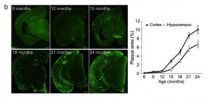(Press-News.org) BOSTON (April 14, 2014)—Nearly one-third of cases of Wilms tumor, a pediatric cancer of the kidney, are linked to a gene called Lin28, according to research from Boston Children's Hospital. Mice engineered to express Lin28 in their kidneys developed Wilms tumor, which regressed when Lin28 was withdrawn, indicating that strategies aimed at blocking or deactivating the gene hold therapeutic promise for children with Wilms. Studies in the mouse model further suggest that controlled expression of Lin28 can promote kidney development and therefore may hold clues to regeneration of damaged kidneys in adults.
The team, led by George Q. Daley, MD, PhD, of Boston Children's, reported their findings online in the journal Genes & Development.
Approximately 500 children in the U.S. are diagnosed with Wilms tumor every year. When examined under a microscope, the tumors resemble immature embryonic kidneys, leading doctors to conclude that Wilms tumors form when kidney development, normally complete by birth, persists into childhood.
Lin28 is closely tied to organ and tissue development in organisms as diverse as worms and humans, and is active in the kidneys early in development. To see whether Lin28 might be a factor in Wilms tumor development, Daley and an international team of collaborators measured the gene's expression in tumor samples from 105 Wilms patients. Nearly one-third of the tumors exhibited high levels of Lin28 activity.
"We found particular association between Lin28 and high-risk 'blastemal' Wilms tumors," says Daley, director of the Stem Cell Transplantation Program at Boston Children's and an investigator with the Howard Hughes Medical Institute. "These tumors often resist therapy but currently cannot be identified prior to treatment. Lin28 may serve as a biomarker for such treatment-resistant tumors."
Achia Urbach, PhD, lead author on the study, engineered a strain of mice to express a Lin28 transgene in the kidneys. The kidneys of those mice were markedly enlarged and continued to grow as long as the Lin28 gene was active. Eventually, those kidneys took on the appearance of Wilms tumors.
"Our data suggest that when Lin28 is active for too long, it keeps the kidneys from completing their developmental program, which would explain Wilms tumors' resemblance to embryonic kidney tissues" says Urbach, a former Boston Children’s researcher, who is now on the faculty of Bar-Ilan University in Israel.
Lin28 is part of a feedback loop with a tumor-suppressing gene called Let-7, with each gene keeping the other in check. Daley and Urbach's team found that they could reverse Lin28's tumor-causing effects in their transgenic model by forcing expression of Let-7, suggesting that treatments targeting Lin28 hold promise for treating Wilms tumors.
The team's insights into the origins of kidney cancer have implications for promoting kidney growth and regeneration. The functional unit of the kidney, called the nephron, forms exclusively during development and if damaged by kidney disease cannot regenerate in the adult. Kidney failure leading to the need for dialysis or kidney transplantation is a major burden to the health care system.
Daley's team showed that a brief, controlled pulse of Lin28 expression in their mouse model increased the numbers of nephrons in newborn mice. Further experimental manipulations of Lin28 may provide a deeper understanding of nephron formation, potentially enabling the restoration of normal numbers of nephrons or their regeneration in damaged adult kidneys.
"Damage to adult kidneys can result in scarring rather than healing, which, if extensive, can lead to kidney failure," Daley says. "Further studies of Lin28 will teach us important lessons about kidney development and point to potential new interventions for kidney disease."
INFORMATION:
The study was supported by the Ellison Medical Foundation and private funds to Boston Children's.
Boston Children's Hospital is home to the world's largest research enterprise based at a pediatric medical center, where its discoveries have benefited both children and adults since 1869. More than 1,100 scientists, including seven members of the National Academy of Sciences, 14 members of the Institute of Medicine and 14 members of the Howard Hughes Medical Institute comprise Boston Children's research community. Founded as a 20-bed hospital for children, Boston Children's today is a 395-bed comprehensive center for pediatric and adolescent health care. Boston Children's is also the primary pediatric teaching affiliate of Harvard Medical School. For more information about research and clinical innovation at Boston Children's, visit: http://vectorblog.org.
Gene linked to pediatric kidney cancer suggests new strategies for kidney regeneration
Lin28, overactive in 30 percent of Wilms tumors, represents a new therapeutic target that also holds promise for regenerating damaged kidneys
2014-04-14
ELSE PRESS RELEASES FROM THIS DATE:
Mechanism, and possible treatment, for immune suppression in liver disease uncovered
2014-04-13
The mechanism which underlies the susceptibility of liver disease patients to life-threatening infection has been uncovered by Wellcome Trust-funded medical scientists, who have also suggested a possible treatment to reverse immune suppression in these patients.
Liver disease, or cirrhosis, is currently the fifth leading cause of death in the UK. Cirrhosis patients are more than five times more likely to pick up infections in hospital than patients with other chronic conditions, due to reduced immunity which is a well-recognised feature of the disease.
In a study published ...
How a Silly Putty ingredient could advance stem cell therapies
2014-04-13
ANN ARBOR—The sponginess of the environment where human embryonic stem cells are growing affects the type of specialized cells they eventually become, a University of Michigan study shows.
The researchers coaxed human embryonic stem cells to turn into working spinal cord cells more efficiently by growing the cells on a soft, utrafine carpet made of a key ingredient in Silly Putty. Their study is published online at Nature Materials on April 13.
This research is the first to directly link physical, as opposed to chemical, signals to human embryonic stem cell differentiation. ...
Fish from acidic ocean waters less able to smell predators
2014-04-13
VIDEO:
Scientists collected fish from the coral reefs shown here and found that fish from the more acidic waters of the bubble reefs were less likely to detect the odor of...
Click here for more information.
Fish living on coral reefs where carbon dioxide seeps from the ocean floor were less able to detect predator odor than fish from normal coral reefs, according to a new study.
The study confirms laboratory experiments showing that the behavior of reef fishes can be seriously ...
Hereditary trauma
2014-04-13
The phenomenon has long been known in psychology: traumatic experiences can induce behavioural disorders that are passed down from one generation to the next. It is only recently that scientists have begun to understand the physiological processes underlying hereditary trauma. "There are diseases such as bipolar disorder, that run in families but can't be traced back to a particular gene", explains Isabelle Mansuy, professor at ETH Zurich and the University of Zurich. With her research group at the Brain Research Institute of the University of Zurich, she has been studying ...
Glasses strong as steel: A fast way to find the best
2014-04-13
Scientists at Yale University have devised a dramatically faster way of identifying and characterizing complex alloys known as bulk metallic glasses (BMGs), a versatile type of pliable glass that's stronger than steel.
Using traditional methods, it usually takes a full day to identify a single metal alloy appropriate for making BMGs. The new method allows researchers to screen about 3,000 alloys per day and simultaneously ascertain certain properties, such as melting temperature and malleability.
"Instead of fishing with a single hook, we're throwing a big net," said ...
Virus-fighting genes linked to mutations in cancer
2014-04-13
Researchers have found a major piece of genetic evidence that confirms the role of a group of virus-fighting genes in cancer development.
Our understanding of the biological processes that cause cancer is limited. UV light and smoking are two well-understood cancer-causing processes. Exposure to either of these processes causes distinguishable patterns of genetic damage, or 'signatures', on the genome that can lead to cancer. All cancer-causing processes leave their own distinct imprint or signature, on the genomes of cancer cells.
The APOBEC family of genes control ...
Tiny particles could help verify goods
2014-04-13
CAMBRIDGE, MA -- Some 2 to 5 percent of all international trade involves counterfeit goods, according to a 2013 United Nations report. These illicit products — which include electronics, automotive and aircraft parts, pharmaceuticals, and food — can pose safety risks and cost governments and private companies hundreds of billions of dollars annually.
Many strategies have been developed to try to label legitimate products and prevent illegal trade — but these tags are often too easy to fake, are unreliable, or cost too much to implement, according to MIT researchers who ...
New mouse model could revolutionize research in Alzheimer's disease
2014-04-13
Alzheimer's disease, the primary cause of dementia in the elderly, imposes a tremendous social and economic burden on modern society. In Japan, the burden of the disease in 2050 is estimated to be a half a trillion US dollars, a figure equivalent to the government's annual revenues.
Unfortunately, it has proven very difficult to develop drugs capable of ameliorating the disease. After a tremendous burst of progress in the 1990s, the pace of discoveries has slowed. Dr. Saido believes that part of the difficulty is the inadequacy of current mouse models to replicate the ...
New technique takes cues from astronomy and ophthalmology to sharpen microscope images
2014-04-13
The complexity of biology can befuddle even the most sophisticated light microscopes. Biological samples bend light in unpredictable ways, returning difficult-to-interpret information to the microscope and distorting the resulting image. New imaging technology developed at the Howard Hughes Medical Institute's Janelia Farm Research Campus rapidly corrects for these distortions and sharpens high-resolution images over large volumes of tissue.
The approach, a form of adaptive optics, works in tissues that do not scatter light, making it well suited to imaging the transparent ...
Finding the switch: Researchers create roadmap for gene expression
2014-04-13
In a new study, researchers from North Carolina State University, UNC-Chapel Hill and other institutions have taken the first steps toward creating a roadmap that may help scientists narrow down the genetic cause of numerous diseases. Their work also sheds new light on how heredity and environment can affect gene expression.
Pinpointing the genetic causes of common diseases is not easy, as multiple genes may be involved with a disease. Moreover, disease-causing variants in DNA often do not act directly, but by activating nearby genes. To add to the complexity, genetic ...
LAST 30 PRESS RELEASES:
University of Phoenix College of Doctoral Studies releases white paper on AI-driven skilling to reduce burnout and restore worker autonomy
AIs fail at the game of visual “telephone”
The levers for a sustainable food system
Potential changes in US homelessness by ending federal support for housing first programs
Vulnerability of large language models to prompt injection when providing medical advice
Researchers develop new system for high-energy-density, long-life, multi-electron transfer bromine-based flow batteries
Ending federal support for housing first programs could increase U.S. homelessness by 5% in one year, new JAMA study finds
New research uncovers molecular ‘safety switch’ shielding cancers from immune attack
Bacteria resisting viral infection can still sink carbon to ocean floor
Younger biological age may increase depression risk in older women during COVID-19
Bharat Innovates 2026 National Basecamp Showcases India’s Most Promising Deep-Tech Ventures
Here’s what determines whether your income level rises or falls
SCIE indexation achievement: Celebrate with Space: Science & Technology
Children’s Hospital Colorado performs region’s first pediatric heart and liver dual organ transplant
Australian team discover why quantum computers have memory problems over time
What determines the fate of a T cell?
Candida auris: genetic process revealed which could be treatment target for deadly fungal disease
Groundbreaking discovery turns household plastic recycling into anti-cancer medication
Blocking a key inflammatory pathway improves liver structure and vascular function in cirrhosis, study finds
Continuous spread: Raccoon roundworm detected in nine European countries
HKUST Engineering researchers developed a novel photodetector to enhance the performance of on-chip light monitoring
Strategic river sensors could have forewarned of Texas Camp flood disaster
Drone sampling of whale breath reveals first evidence of potentially deadly virus in Arctic
Roman soldiers defending Hadrian’s Wall infected by parasites, study finds
Pinochet’s prisoners were tormented with music but still found solace in it, a new book reveals
Fertility remains high in rural Tanzania despite access to family planning
AI-assisted device can improve autism care access
Kinetic careers
Uncovering how parasitic plants avoid attacking themselves to improve crop resistance
Nanoparticle vaccine strategy could protect against Ebola and other deadly filoviruses
[Press-News.org] Gene linked to pediatric kidney cancer suggests new strategies for kidney regenerationLin28, overactive in 30 percent of Wilms tumors, represents a new therapeutic target that also holds promise for regenerating damaged kidneys




